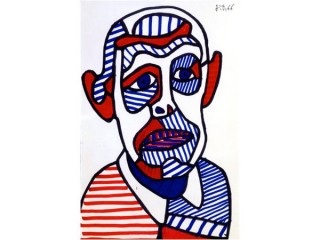
Jean Dubuffet (En.) biography
Date of birth : 1901-07-31
Date of death : 1985-05-12
Birthplace : Le Havre, France
Nationality : French
Category : Famous Figures
Last modified : 2011-07-22
Credited as : Artist painter, sculptor,
Jean Dubuffet was born on July 31, 1901, in Le Havre, the son of a wealthy wine merchant, whose lifestyle young Jean found bourgeois. He began attending art classes when he was 15 years old, and in 1918 he went to Paris to study painting at the Academie Julian. Six months later he left school to paint on his own.
Questioning his originality and the value of art and of culture, Dubuffet stopped painting in 1923, traveled to Italy and Brazil, but returned to Le Havre in 1925 to study commerce. He married Paulette Brey in 1927, with whom he had a daughter, but they divorced just a few years later, and remarried just a few years after that. In 1930 he began a wine business in Paris which he subsequently left in the hands of an associate to resume painting. He returned again to the wine business in 1937 when the associate was failing at it, but when war broke out in 1939 he closed it down. From 1942 on he devoted himself exclusively to painting, allowing a new, more capable associate run the business until it was sold in 1946.
Dubuffet had his first exhibition in 1944 in Paris. With a crudeness reminiscent of the art brut (raw art) he so much admired, Dubuffet portrayed such ordinary subjects as people riding the Paris subway and a girl milking a cow. He was attempting "to bring all disparaged values into the limelight." These early paintings display the interest in texture, earth colors, and ironic humor that is characteristic of all Dubuffet's work. He researched the style of drawings done by children and the insane, and applied those to his works.
When Dubuffet's second major show took place in Paris in 1946, the popular response was one of outrage. Strongly influenced by graffiti, Dubuffet had broken all accepted visual conventions by his choice of subject and technique.
Spurred by his interest in naive art, Dubuffet made his first visit to North Africa in 1947. He made two subsequent visits to the Sahara between 1947 and 1949, and he responded to his experience by creating works in which landscape and texture became increasingly important.
In 1950 Dubuffet began a series of paintings of female nudes which he called Corps de Dames. The formless, grotesque, and often humorous figures represent the direct antithesis to classical proportion and beauty. Dubuffet wrote extensively about his rejection of esthetic conventions, which was a current running through all his work.
Because of his wife's ill health Dubuffet moved to Vence in the south of France in 1955. He was increasingly preoccupied with creating a new kind of landscape painting. With an inventiveness that is typical of his approach to his work, he tried out new methods, which included scattering sand on the painting, scratching it with a fork, and assembling pictures out of butterfly wings. From the new techniques and materials arose a rich variety of works, among them a cycle called Texturologies. These pictures, which celebrate the ground and contain no figures, appear to be nonrepresentational, but Dubuffet's works, however abstract they may appear, are always about something. The Texturologies are about matter, and by using the same thick impasto that he used to depict figures he suggests the oneness of nature and man.
When Dubuffet returned to Paris in 1961, he again took to depicting people and their environment. The bright colors and subject matter of these works recall the panoramas of city life he painted in 1943-1944. This return to an earlier style and subject matter was characteristic of Dubuffet; there was in his work a fundamental consistency in its dedication to "disparaged values" and in its aim of removing the boundaries between man and nature.
In 1962 Dubuffet moved to Le Touquet. At this time he began his longest series, entitled L'Hourloupe (a word he invented), which possess a decorative quality that is not evident in his earlier work. He also continued to paint everyday subjects, concentrating on inanimate objects such as typewriters, scissors, and clocks. In spite of their stylistic departure, these paintings are consistent with Dubuffet's entire output in their humor and naivete.
Most of Dubuffet's later works involved large painted polyester resin sculptures, which still retain his offbeat sense of humor yet also have a grotesque and violent nature to them. Some critics consider him a predecessor to later trends in Pop Art and Neo-Dada. He died in 1985.
















